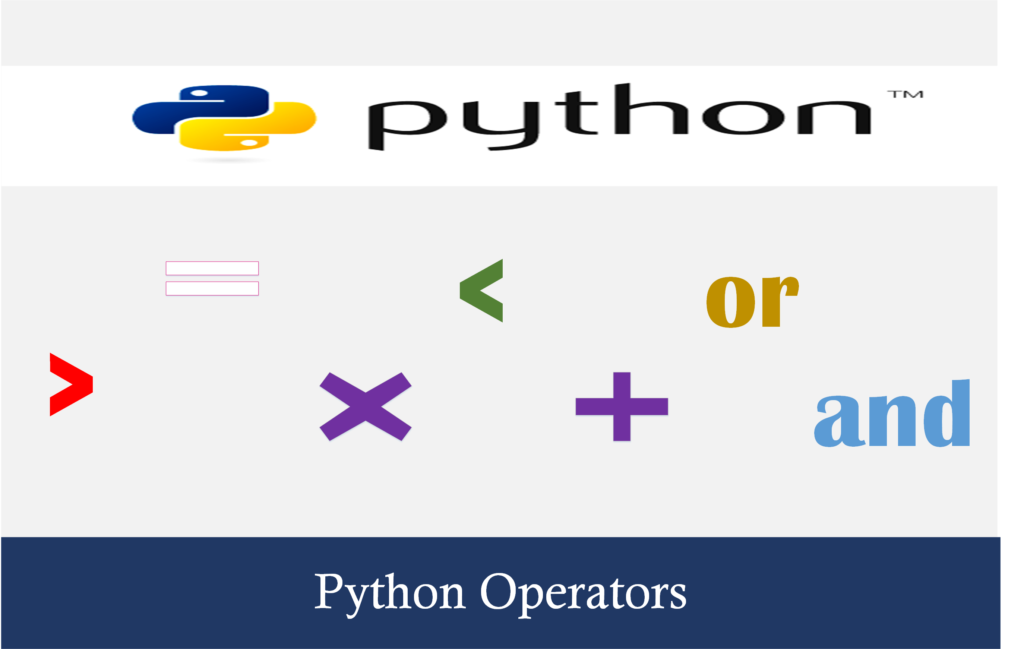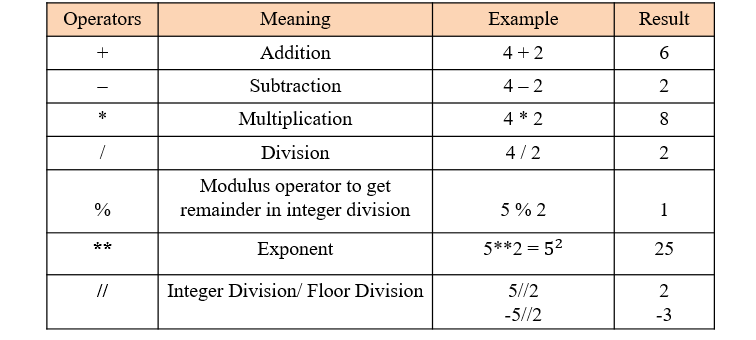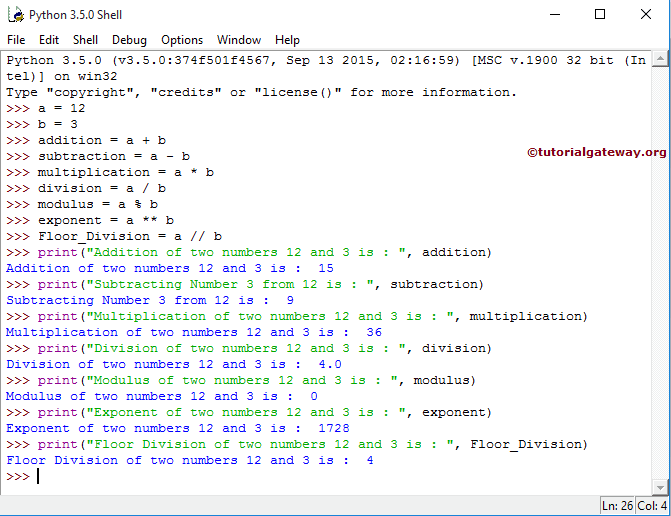The symbol in Python is called the Modulo Operator. Additionally it evaluates the expressions 3 2 9.
 Operators In Python With Examples Dot Net Tutorials
Operators In Python With Examples Dot Net Tutorials
Python divides the operators in the following groups.

What does mean in python arithmetic operators. Is known as an exponent operator. Divides left hand operand by right hand operand and returns remainder. There are various methods for arithmetic calculation in Python like you can use the eval function declare variable calculate or call functions.
In Python is the addition operator. The values that an operator acts on are called operands. Arithmetic operators are used to perform mathematical operations like addition subtraction multiplication and division.
Operators that perform operations on two operands are known as binary operators. Various arithmetic calculations like addition subtraction multiplication division floor division modulus exponent etc. In this case the operator adds the operands a and b together.
Can be performed using arithmetic operators. The modulo operator is considered an arithmetic operation along with -. Here 4 and 5 are called operands and is called operator.
Arithmetic Operators In Python. The operator is an example of a Python assignment operator. Here is the operator that performs addition.
Getting Started Mean Median Mode Standard Deviation Percentile Data Distribution Normal Data Distribution Scatter Plot Linear Regression Polynomial Regression Multiple Regression Scale TrainTest. Python provides multiple ways for arithmetic calculations like eval function declare variable calculate or call functions. Arithmetic Operators perform various arithmetic calculations like addition subtraction multiplication division modulus exponent etc.
There are 7 arithmetic operators in Python. Python Arithmetic operators include operators like Addition Subtraction Multiplication Division Floor Division Exponent or Power and Modulus. There are several methods for arithmetic computation in Python like you can use the eval function declare variable calculate or call functions.
Performs exponential power calculation on operators. The table below outlines the built-in arithmetic. Python Arithmetic Operators.
Are used to perform simple arithmetic operations in python. In Python operators are special symbols that designate that some sort of computation should be performed. B a 0.
The Python operator performs an addition operator and then assigns the result of the operation to a variable. Can be used for arithmetic calculations in python. Various methods like eval function call functions declare the variable and calculate etc.
With arithmetic operators we can do various arithmetic operations like addition subtraction multiplication division modulus exponent etc. Similarly is known as a multiplication operator. It is used to add 2 values.
So lets open up your PyCharm and perform a simple task using these operators as shown in below figure. What does Arithmetic Operator mean. Addition subtraction - multiplication division exponents Review the cells below to explore mathematical operators in Python.
The value that the operator operates on is called the operand. In Python there are many arithmetic operations that can be completed including operators for. Its used to get the remainder of a division problem.
It returns the remainder of dividing the left hand operand by right hand operand. Operators are the constructs which can manipulate the value of operands. I used a single star for multiplication and a double star for the square power.
Operators are special symbols in Python that carry out arithmetic or logical computation. Python Operator falls into 7 categories. Arithmetic Operators perform different arithmetic computations like addition subtraction multiplication division modulus exponent etc.
Arithmetic Operators in Python. This tutorial discussed with reference to an example the basics of Python operators and how to use the. A 10 b 20 a b 30.
They are used in common arithmetic and most computer languages contain a set of such operators that can be used within equations to perform a number of types of sequential calculation. All these Arithmetic operators in Python are binary operators which means they operate on two operands. The arithmetic operators in Python are used to perform math operations.
Here is an example. Python language supports the following types of operators. The below table shows all the Python Arithmetic Operators with examples.
Consider the expression 4 5 9. 2 and 3 are the operands and 5 is the output of the operation. An operand is a variable or a value on which we perform the operation.
An arithmetic operator is a mathematical function that takes two operands and performs a calculation on them. This operator is called the addition assignment operator. Ab 10 to the power 20.
Python operator is a symbol that performs an operation on one or more operands. Floor Division - The division of operands where the result is the quotient in which the digits after the decimal point are removed. Arithmetic operators - etc.
Arithmetic operators are used with numeric values to perform common mathematical.
 Different Types Of Operators In Python By Rinu Gour Medium
Different Types Of Operators In Python By Rinu Gour Medium
 Python Operators Arithmetic Logical Relational Assignment Bitwise
Python Operators Arithmetic Logical Relational Assignment Bitwise
 Evaluation Of Expressions Type Conversion Precedence And Associatively I O Functions
Evaluation Of Expressions Type Conversion Precedence And Associatively I O Functions
 Python Operators And Expressions Make Me Analyst
Python Operators And Expressions Make Me Analyst
 Python Operator Of Precedence Programming Class Study Com
Python Operator Of Precedence Programming Class Study Com
 Python Arithmetic Operators Example W3ki
Python Arithmetic Operators Example W3ki
 Arithmetic Operators In Python Devopsschool Com
Arithmetic Operators In Python Devopsschool Com
 Python Question Arithmetic Operators Python Cppsecrets Com
Python Question Arithmetic Operators Python Cppsecrets Com
 Pasiteisinimas Analizuoti Nuostabu Python Modulo Florencepoetssociety Org
Pasiteisinimas Analizuoti Nuostabu Python Modulo Florencepoetssociety Org
 Java Arithmetic Operators With Examples Geeksforgeeks
Java Arithmetic Operators With Examples Geeksforgeeks

0 comments:
Post a Comment